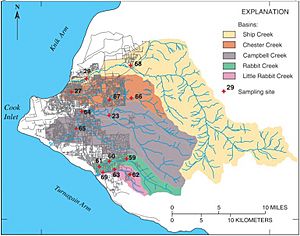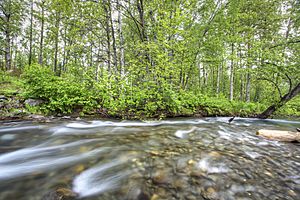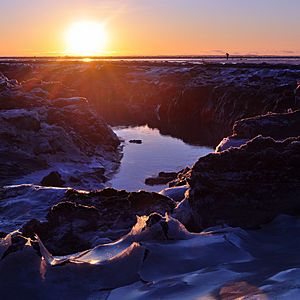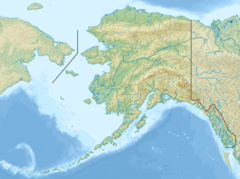Campbell Creek (Alaska) facts for kids
Quick facts for kids Campbell Creek |
|
|---|---|

Campbell Creek looking upstream from the Old Seward Highway bridge, where it passes through a somewhat densely-populated stretch on the southern fringes of midtown Anchorage
|
|

Watersheds of Anchorage rivers, with Campbell Creek in gray
|
|
|
Location of the mouth of Campbell Creek in Alaska
|
|
| Native name | Qin Cheghitnu |
| Country | United States |
| State | Alaska |
| Municipality | Anchorage |
| Physical characteristics | |
| Main source | Confluence of north and south forks Long Lake (North fork), Williwaw Lakes (Middle fork), Green Lake (South fork) |
| River mouth | Turnagain Arm, Anchorage 61°07′26″N 149°58′37″W / 61.124°N 149.977°W |
| Length | 21 mi (34 km) |


Campbell Creek is a cool stream that flows right through Anchorage, Alaska. It's about 21 mi (34 km) long, starting high up in the Chugach Mountains and ending in the Turnagain Arm of Cook Inlet.
This creek starts when its North and South Forks join together. It then flows southwest, passing through Campbell Lake before reaching the Turnagain Arm. Many smaller streams, like Little Campbell Creek and Middle Fork, also flow into it.
Campbell Creek connects many parks, open spaces, and lakes. It creates a green pathway that runs from east to west across the city. A paved path called the Campbell Creek Trail follows the creek for about seven miles, from Campbell Park to Campbell Lake.
What's the History of Campbell Creek?
Long before English-speaking settlers came to Anchorage, the Dena'ina people lived in this area. They called the creek Qin Cheghitnu, which means "Crying Ridge Creek."
The "Crying Ridge" was a mountain peak called Tanaina Peak in the Chugach Mountains. This place was special to the Dena'ina people and was seen as a place for showing sadness.
The name "Campbell Creek" that we use today comes from Point Campbell. This is the spot where the Knik and Turnagain arms of Cook Inlet meet.
How Do People Use Campbell Creek?
Campbell Creek is a popular spot, especially in the summer. People enjoy floating down the creek in inner tubes. It's also a great place for kayaking.
How Does Campbell Creek Flow?
The USGS has been measuring how much water flows in Campbell Creek since 1966. They have a special tool called a stream gauge at the Dimond Boulevard Bridge. This tool measures the water flow from an area of about 69.7 square miles (181 km2).
From 1966 to 2013, the average water flow was about 67.7 cubic feet per second (1.92 m3/s). The lowest flow ever recorded was in February 1969, when it was only 2.2 cubic feet per second (0.062 m3/s).
The highest water level ever recorded in the creek was in August 1989. The water reached a height of 23 feet (7.0 m) at the gauge. This meant a very strong flow of 1,510 cubic feet per second (43 m3/s)!


